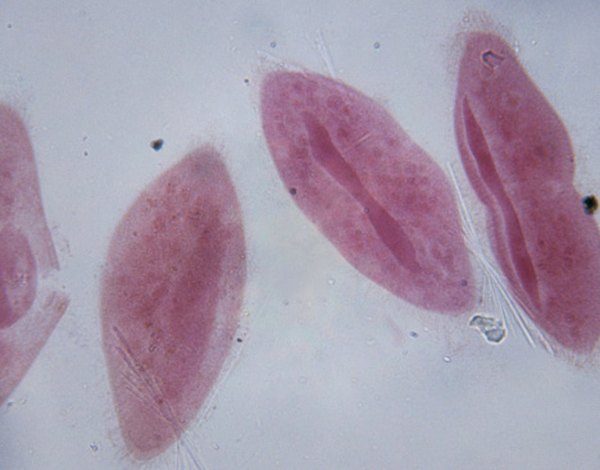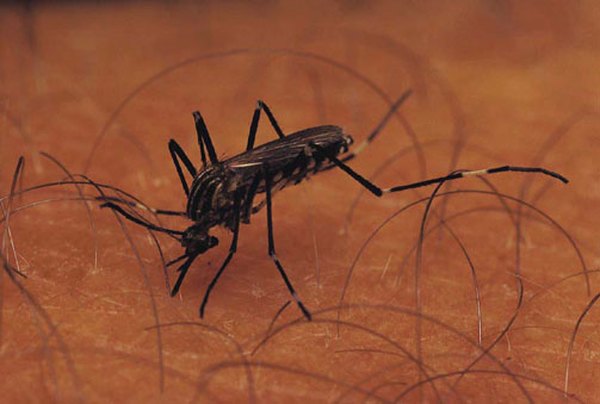What Are Some Examples Of Animal Like Protists
Protists are called plant-like, fungus-like and fauna-like considering they share some of the characteristics of plants, fungi and animals, even though they belong in a dissimilar category: the kingdom Protista. They are all eukaryotes (that is, they have a nucleus) and all alive in moist conditions, whether in saltwater, freshwater or within other organisms.
They have merely one jail cell, though some appear as multicelled as they live in colonies. Brute-like protists are too called animal-like protozoa, or "commencement animals," as they developed from bacteria to become the evolutionary forebears of more than complex animals.
Full general Characteristics of Protozoans and Protozoa Definition
The protozoa definition involves their domain of eukarya (protists are eukaryotic), their own split kingdom of protista and how they consume. Nigh all protozoans are heterotrophs -- that is, they find food from their environment as they cannot make their own within the prison cell every bit plants practise. The cell is surrounded by a membrane and contains tiny structures called organelles, including mitochondria and digestive vacuoles, which acquit out essential functions such every bit converting oxygen and nutrient to energy.
Read more than about the differences between protozoa and protists.
At that place are four main types of protozoans, classified according to how they motility and where they live:
- Rhizopoda (animal-similar protists with "fake anxiety" called pseudopodia)
- Ciliates (protists covered in tiny hairlike cilia)
- Flagellates (protists with whiplike "tails")
- Sporozoa (parasitic protists)
Most amoebas, ciliates and flagellates are free living and form an important part of the ecosystem by suppressing certain leaner and serving as a food source for larger organisms.
Rhizopoda
The main animal-similar protozoa in this group are amoebas, which alive in freshwater or as parasites and foraminifers that live in the sea and form shells. They are all characterized by pseudopodia ("false feet") -- lobes or fingerlike bulges of cytoplasm, which enable them to move. They feed on bacteria and smaller protozoans by capturing them in their pseudopodia and engulfing them in vacuoles, where enzymes digest them.
Waste and excess water pass out through holes in the prison cell membrane. Amoebas reproduce asexually by binary fission where the nucleus splits into two and a new cell forms round each. Foraminifers reproduce differently in alternating generations -- asexually by fission, and then sexually past joining together to exchange nucleic material. A few amoebas live as parasites; for example, entamoeba, the source of amoebic dysentery.
Ciliates

••• Duncan Smith/Photodisc/Getty Images
Ciliates, such as paramecium, have tiny hairlike structures chosen cilia growing from their surfaces. The cilia propel them through water and capture food by wafting it into a mouthlike groove in the surface membrane. They feed on algae and bacteria, and are in plough eaten by larger protozoans, such equally amoeba.
Read more about the main functions of cilia and flagella.
Ciliates take more than one nucleus: a large ane that governs everyday functions and smaller ones for reproductive purposes. Some ciliates reproduce both sexually and asexually -- first they join together to exchange reproductive nuclei, and then the resulting double nuclei split up to create new cells.
Flagellates
Flagellates are animate being-like protozoa that accept a whip or tail-like construction to propel them through the water. A few, the phytoflagellates, can brand their own food through photosynthesis, as plants do. Others engulf food particles into vacuoles or absorb molecules of nutrients through their surface membrane.
Most flagellates reproduce past fission, but some reproduce sexually by fusing with each other before dividing. Some flagellates are parasitic; for example, trypanosoma and giardia crusade sleeping sickness and giardiasis (diarrhea and vomiting) respectively.
Sporozoa

••• Stockbyte/Stockbyte/Getty Images
Sporozoans are parasitic -- they alive on, or in, a host body and cause it harm. Lacking cilia, flagella or pseudopodia, sporazoa depend on their host organism for nourishment and on vectors, such as mosquitoes, to comport them at that place. They pass from host to host, or vector to host, equally spores.
Sporozoa are too called apicomplexa because they have an "apical complex," a structure that produces enzymes and enables the protist to wedge itself into the host cell. Reproduction has both sexual and asexual stages.
Source: https://sciencing.com/characteristics-animallike-protists-8522528.html
Posted by: roddeneaddelartion.blogspot.com

0 Response to "What Are Some Examples Of Animal Like Protists"
Post a Comment